Singer old sewing machine manuals provide essential guidance for operating‚ maintaining‚ and troubleshooting vintage models like the 201‚ 99K‚ and 66K. These resources‚ often available as free PDF downloads‚ detail setup‚ stitch customization‚ and repair tips‚ ensuring optimal performance for enthusiasts and collectors alike.
Overview of Singer Sewing Machine History
Singer sewing machines have a rich history dating back to the mid-19th century‚ with the company founded in 1851. By 1863‚ Singer held 22 patents and sold 20‚000 machines annually‚ growing rapidly to become a household name. Known for innovation‚ Singer introduced models like the 201‚ 99K‚ and 66K‚ which became iconic for their durability and functionality. The company’s success was fueled by its ability to make sewing accessible to both industrial and domestic users. Over the years‚ Singer sewing machines evolved‚ adapting to technological advancements while maintaining a reputation for quality. Today‚ vintage Singer machines are highly sought after by collectors and enthusiasts‚ showcasing the brand’s enduring legacy in the sewing industry.
Importance of Manuals for Vintage Sewing Machines
Singer old sewing machine manuals are indispensable for maintaining and operating vintage models effectively. They provide detailed guidance on setup‚ maintenance‚ and troubleshooting‚ ensuring machines run smoothly. These manuals are crucial for understanding stitch capabilities‚ customization options‚ and repair techniques‚ preserving the functionality of classic devices. For enthusiasts and collectors‚ they serve as invaluable resources‚ offering insights into the machines’ history and operation. Manuals also help users avoid costly repairs by addressing common issues early. Their availability in PDF formats makes them accessible‚ ensuring vintage Singer machines remain functional and cherished for generations. Whether for practical use or historical interest‚ these manuals are essential for anyone working with vintage sewing machines.
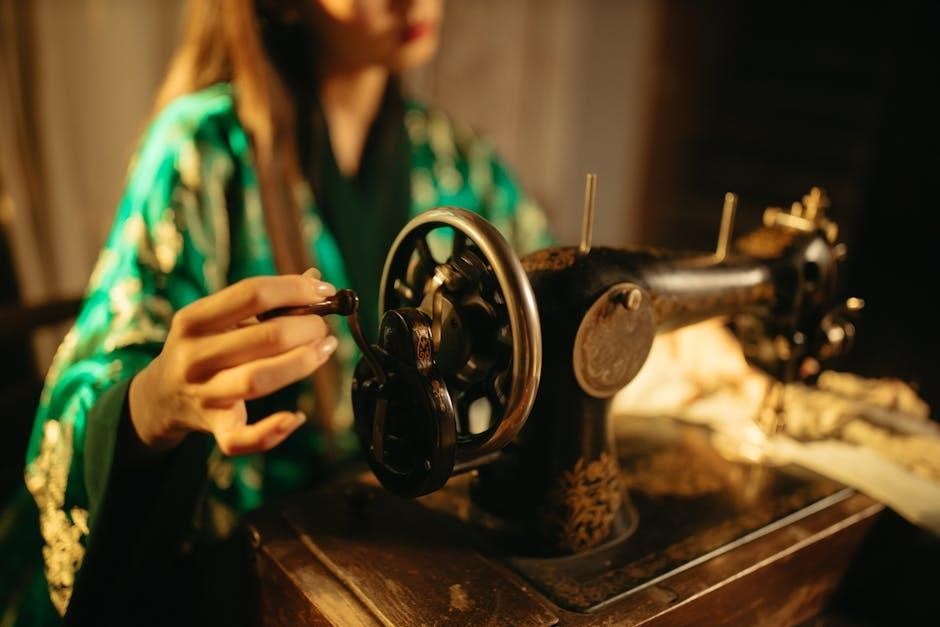
Popular Models Covered in Singer Manuals
Singer manuals cover iconic models like the 201‚ 99K‚ and 66K‚ providing detailed guidance for these popular vintage sewing machines‚ ensuring optimal performance and user satisfaction.
Singer Model 201: The Best Vintage Sewing Machine
The Singer Model 201 is widely regarded as one of the finest vintage sewing machines available‚ celebrated for its durability‚ versatility‚ and exceptional stitch quality. Known for its mechanical operation‚ it offers a wide range of stitch options and is particularly favored for its reliability and ease of use. Manuals for the Model 201 are readily available in PDF format‚ providing detailed instructions for setup‚ maintenance‚ and troubleshooting. These guides are essential for both enthusiasts and collectors‚ ensuring the machine’s optimal performance. With its timeless design and robust construction‚ the Singer 201 remains a top choice for those seeking a high-quality vintage sewing experience.
Singer Model 99K: A Classic Choice for Enthusiasts
The Singer Model 99K is a beloved choice among sewing enthusiasts and collectors‚ renowned for its durability and ease of use. This vintage machine is highly sought after for its versatility in handling various fabrics and stitches. Manuals for the Singer 99K are widely available in PDF format‚ offering detailed guidance on setup‚ maintenance‚ and troubleshooting. These resources are invaluable for both novice users and experienced sewists‚ ensuring the machine runs smoothly. With its robust construction and timeless design‚ the Singer 99K remains a favorite for those passionate about vintage sewing‚ providing a reliable and enjoyable sewing experience for years to come.
Singer Model 66K: Features and Capabilities
The Singer Model 66K is a durable and versatile sewing machine‚ celebrated for its mechanical simplicity and robust performance. It excels at straight-stitch sewing‚ making it ideal for quilting‚ repairs‚ and heavy-duty projects. The machine’s compact design and portability add to its appeal‚ while its intuitive operation suits both beginners and experienced sewists. Manuals for the Singer 66K provide detailed instructions for setup‚ maintenance‚ and troubleshooting‚ ensuring optimal use. Its reliability and ease of repair have made it a favorite among collectors and enthusiasts of vintage sewing machines. With its timeless design and practical features‚ the Singer 66K remains a top choice for those who value classic sewing technology.
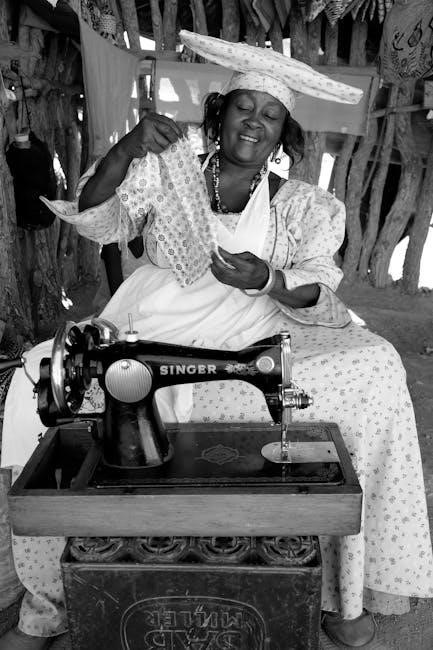
Contents of a Singer Old Sewing Machine Manual
Singer old sewing machine manuals include detailed setup instructions‚ stitch customization options‚ troubleshooting guides‚ maintenance tips‚ and diagrams to ensure proper operation and care of your machine.
Setup and Initial Configuration
Setting up a vintage Singer sewing machine begins with unpacking and placing it on a stable surface. Manuals guide users through aligning the machine properly‚ ensuring the bobbin is correctly loaded‚ and threading the machine accurately. Instructions often include step-by-step diagrams to help users understand the process. Proper needle installation and stitch selection are also covered to ensure smooth operation. Many manuals emphasize the importance of testing the machine with scrap fabric before starting a project. This initial configuration ensures optimal performance and helps users familiarize themselves with the machine’s features. Clear guidelines are provided to avoid common setup mistakes and ensure a seamless sewing experience.
Stitch Type Capabilities and Customization
Vintage Singer sewing machines are renowned for their versatile stitch capabilities‚ which are detailed in their manuals. Models like the 201‚ 99K‚ and 66K offer a variety of stitches‚ including straight‚ reverse‚ and decorative options. Manuals provide instructions on how to customize stitch length‚ width‚ and tension to suit different fabrics and sewing projects. Many models also support interchangeable presser feet‚ enabling specialized tasks like zigzag stitching or embroidery. These features allow users to tailor their sewing experience‚ whether crafting clothes‚ repairing items‚ or creating intricate designs. The manuals often include diagrams and charts to guide users in selecting the right stitch settings‚ ensuring precise and professional results. This customization flexibility is a hallmark of Singer’s legacy in sewing innovation.
Maintenance and Troubleshooting Tips
Maintenance is crucial for preserving the functionality of vintage Singer sewing machines. Manuals emphasize regular cleaning and lubrication to prevent mechanical issues. Oil ports and moving parts should be lubricated periodically to ensure smooth operation. Troubleshooting common problems‚ such as thread breakage or fabric jamming‚ is also covered in detail. Users are advised to check tension settings‚ clear lint buildup‚ and inspect needles for damage. For more complex issues‚ manuals provide step-by-step guides for diagnosing and resolving faults. Additionally‚ tips on replacing worn parts and adjusting components help maintain performance. By following these guidelines‚ users can extend the lifespan of their machines and address minor problems before they escalate‚ keeping their Singer sewing machine in optimal working condition for years.
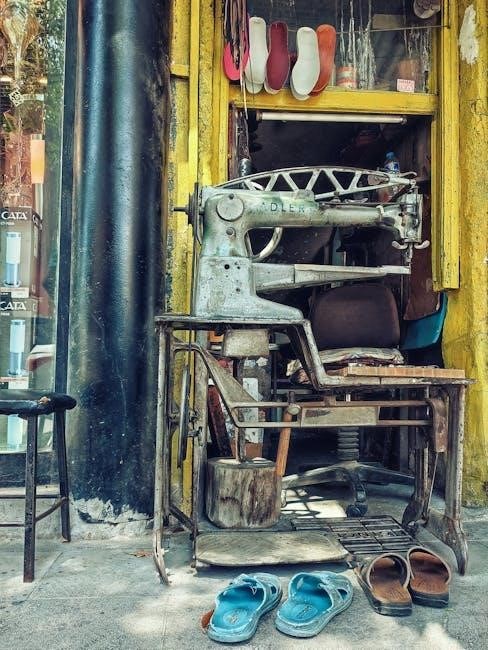
Maintenance and Care for Vintage Singer Machines
Regular cleaning‚ lubrication‚ and tension adjustments are vital for maintaining vintage Singer machines. Replacing worn parts and following manual guidelines ensure longevity and optimal performance.
Cleaning and Lubrication Guidelines
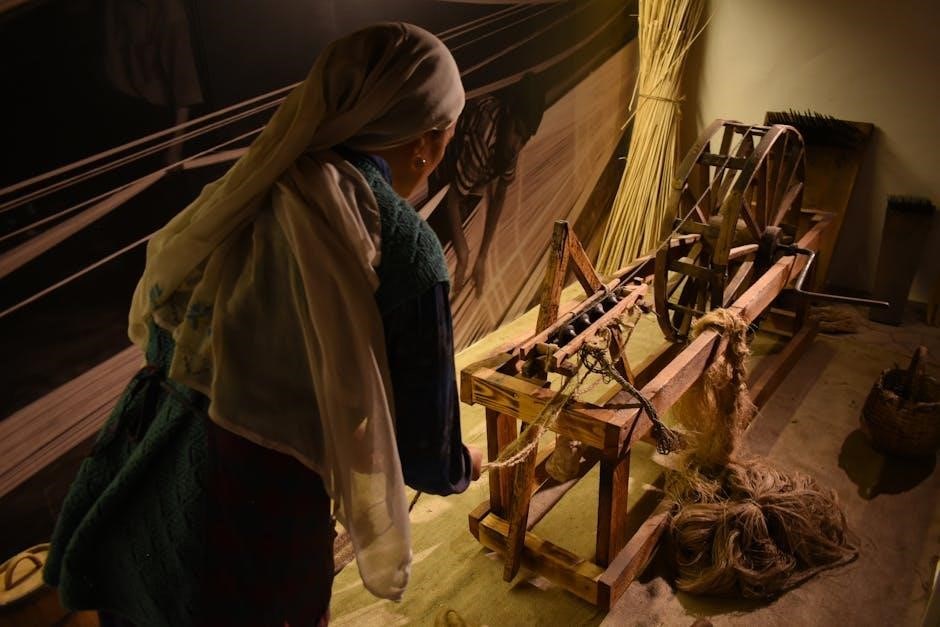
Proper cleaning and lubrication are essential for maintaining vintage Singer sewing machines. Use a lint brush or small vacuum to remove dust and debris from the bobbin area and tension discs. Apply a few drops of high-quality sewing machine oil to moving parts‚ such as the shuttle hook and gears‚ to ensure smooth operation. Avoid using harsh chemicals or excessive oil‚ as this can damage the machine. Regularly wipe down the exterior with a soft‚ dry cloth or a microfiber cloth to prevent rust. Cleaning should be done after each heavy use‚ while lubrication is recommended every 3-6 months‚ depending on usage. Always refer to the manual for specific guidelines tailored to your Singer model.
Replacing Parts and Accessories
Replacing parts on vintage Singer sewing machines requires careful selection of genuine or compatible components. Start by identifying the specific part needed‚ such as bobbin cases‚ needles‚ or feed dogs‚ using the manual or online resources. For models like the 201‚ 99K‚ and 66K‚ ensure compatibility by cross-referencing part numbers. Use high-quality tools to remove old parts and install new ones securely. Lubricate moving parts post-installation for smooth operation. Regularly check for worn or damaged components to prevent further damage. Source parts from trusted suppliers or Singer-authorized dealers to maintain machine performance. Always refer to the manual for detailed instructions tailored to your Singer model‚ ensuring a successful replacement process. This helps preserve the machine’s functionality and longevity for years of reliable use.
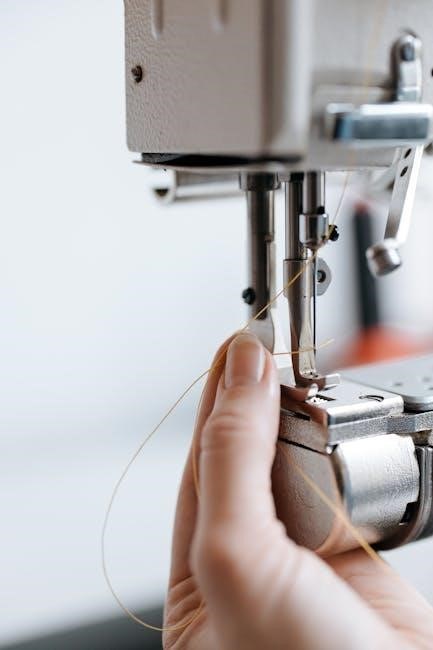
Common Issues and DIY Fixes
Vintage Singer sewing machines may encounter issues like fabric jamming‚ uneven stitching‚ or bobbin tension problems. Often‚ these can be resolved with simple DIY fixes. Cleaning the machine thoroughly‚ especially the bobbin area and feed dogs‚ can prevent jams. Lubricating moving parts with sewing machine oil ensures smooth operation. For uneven stitches‚ check and adjust the tension dials as outlined in the manual. If the machine is noisy‚ inspect for loose screws or worn belts‚ which can be tightened or replaced. For models like the Singer 201 or 99K‚ ensure the needle is correctly aligned and the presser foot is functioning properly. These DIY fixes‚ detailed in Singer manuals‚ empower users to maintain their machines effectively‚ extending their lifespan and performance.

Historical Significance of Singer Sewing Machines
Singer sewing machines revolutionized sewing in the 19th century‚ transforming both industrial and household sewing. Their innovative designs and widespread adoption made them a cornerstone of textile history.
Evolution of Singer Sewing Machines Over the Years
Singer sewing machines have undergone significant transformations since their inception in the 19th century. The first practical sewing machine‚ patented in 1851‚ laid the foundation for a legacy of innovation. By 1863‚ Singer held 22 patents and sold 20‚000 machines annually‚ rising to 180‚000 by 1871. The introduction of models like the 201‚ 99K‚ and 66K showcased advancements in durability and functionality. These machines became iconic for their reliability and versatility‚ catering to both home use and industrial applications. Over the years‚ Singer adapted to technological advancements‚ transitioning from mechanical to electronic and computerized models‚ ensuring their relevance in the modern era. This evolution highlights Singer’s enduring impact on the sewing industry.
Impact on the Sewing Industry and Household Use
Singer sewing machines revolutionized the sewing industry by enabling mass production of clothing and textiles‚ making them more affordable and accessible. Their durability and versatility transformed household sewing‚ empowering individuals to create and repair garments efficiently. The widespread adoption of Singer machines helped establish the company as a household name‚ with sales reaching 180‚000 units annually by 1871. This impact extended beyond industry‚ fostering a cultural shift in DIY fashion and home economics. Singer’s contributions remain pivotal in the evolution of sewing‚ both industrially and domestically‚ leaving a lasting legacy in the way people create and produce textiles globally.

Downloading Singer Sewing Machine Manuals
Singer sewing machine manuals are widely available as free PDF downloads‚ covering models like 201‚ 99K‚ and 66K. Websites like ismacs.net offer reliable resources for enthusiasts.
Free PDF Downloads and Resources
Free PDF downloads of Singer sewing machine manuals are readily available online‚ offering comprehensive guides for vintage models like the 201‚ 99K‚ and 66K. Websites such as ismacs.net provide scans of original manuals‚ ensuring authenticity and accessibility. These resources include detailed instructions for setup‚ maintenance‚ and troubleshooting‚ making them invaluable for enthusiasts. Specific models‚ like the Singer 15-91 and 401‚ are covered in downloadable PDFs‚ often with file sizes ranging from 1.2MB to 14.05MB. Users can instantly access these manuals‚ which are optimized for viewing and printing. Such resources are essential for preserving the functionality and heritage of vintage Singer sewing machines‚ catering to both collectors and active users seeking reliable guidance.
Where to Find Reliable Manuals Online
Reliable Singer old sewing machine manuals can be found on trusted websites like ismacs.net‚ which offers free PDF downloads for models such as the Singer 201‚ 99K‚ and 66K. Official Singer websites and sewing enthusiast forums also provide authentic resources. Websites like Sewing Parts Online and Vintage Sewing Machines host extensive libraries of manuals‚ ensuring easy access for collectors and restorers. Additionally‚ communities on platforms like Reddit (e.g.‚ r/VintageSewing) often share links to rare and hard-to-find manuals. These online resources are invaluable for maintaining and operating vintage Singer machines‚ offering both free and paid options to suit different needs and preferences.
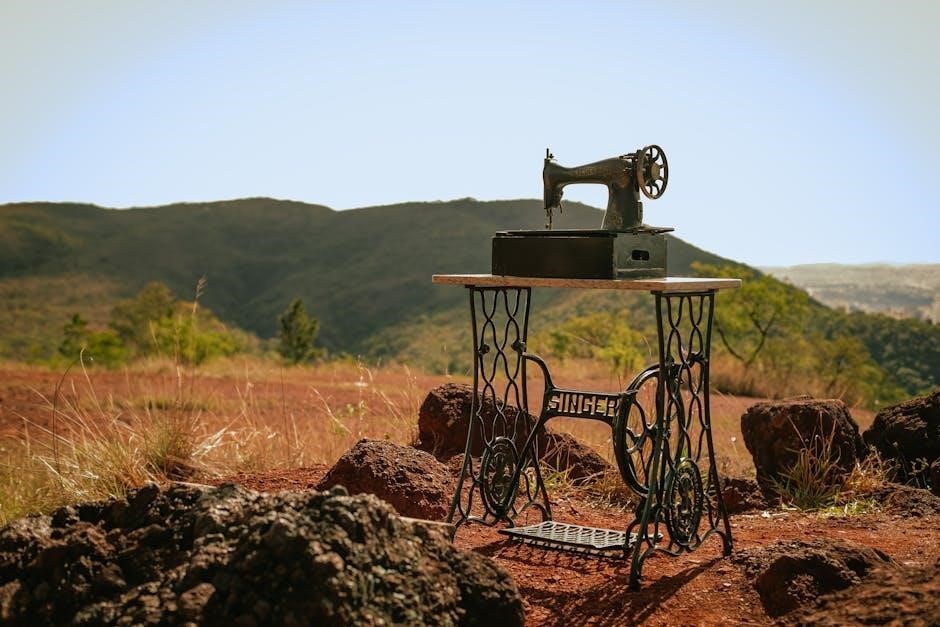
Community and Support for Vintage Sewing Machines
Active communities on Reddit (r/VintageSewing) and Facebook groups connect enthusiasts‚ offering advice‚ repair tips‚ and shared knowledge for Singer vintage machines‚ fostering a supportive network.
Online Forums and Groups for Enthusiasts
Online forums and groups dedicated to vintage sewing machines‚ such as Reddit’s r/VintageSewing and specialized Facebook groups‚ provide a vibrant space for enthusiasts to share knowledge and resources. These platforms are ideal for discussing Singer manuals‚ troubleshooting‚ and exchanging tips on maintenance and repair. Members often post scans of rare manuals‚ offer advice on restoring machines‚ and showcase their projects. Additionally‚ communities like the International Sewing Machine Collectors’ Society (ISMCS) cater to serious collectors‚ offering in-depth discussions and access to historical documentation. These forums foster camaraderie among hobbyists and professionals‚ ensuring the preservation and appreciation of vintage sewing culture.
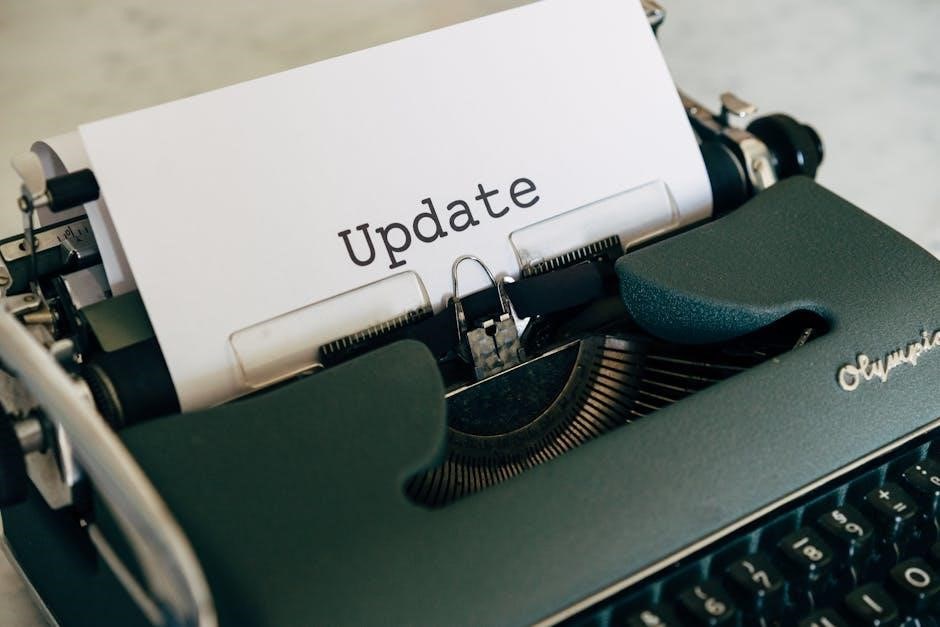
Expert Repair Services and Advice
Expert repair services for vintage Singer sewing machines are available through specialists like Larry Flanagan‚ who has decades of experience and a deep understanding of Singer models. These professionals offer comprehensive maintenance‚ complex repairs‚ and guidance on restoring machines to their original functionality. Many technicians provide advice tailored to specific Singer models‚ ensuring accurate troubleshooting and efficient solutions. Online platforms and communities‚ such as the International Sewing Machine Collectors’ Society (ISMCS)‚ connect enthusiasts with skilled repairers and offer access to detailed repair guides and historical documentation. These resources are invaluable for preserving the functionality and heritage of vintage Singer machines‚ ensuring they continue to operate smoothly for years to come.
Singer old sewing machine manuals are invaluable resources for preserving and maintaining vintage machines‚ offering insights into their history and functionality for enthusiasts and collectors alike.
Final Thoughts on Using Singer Manuals
Using Singer old sewing machine manuals is an essential step in preserving the functionality and historical charm of vintage models. These manuals provide detailed setup guides‚ maintenance tips‚ and troubleshooting solutions‚ ensuring that enthusiasts can keep their machines in optimal condition. By following the instructions‚ users can unlock the full potential of their Singer sewing machines‚ from stitch customization to repair techniques. Whether you’re a seasoned collector or a new hobbyist‚ these manuals empower you to maintain and enjoy your vintage Singer machine with confidence and precision. They not only preserve the legacy of these iconic devices but also offer a sense of accomplishment in DIY repairs and maintenance.
Encouragement to Explore Vintage Sewing
Exploring vintage sewing offers a rewarding journey into creativity‚ history‚ and craftsmanship. Owning and using a Singer old sewing machine manual empowers enthusiasts to restore and operate timeless devices‚ fostering a deeper connection to the past. These machines‚ with their durable construction and versatile stitch capabilities‚ are not only functional but also treasured collectibles. By embracing vintage sewing‚ you join a community of passionate hobbyists who value tradition and sustainability. The satisfaction of bringing a classic machine back to life‚ coupled with the joy of creating handmade items‚ makes vintage sewing a fulfilling and enriching hobby for anyone willing to explore its charm.

